In the January transfer window, Borussia Dortmund opted to sign Emre Can on a loan deal until the end of the season after the German international fell out of favour at Juventus under Maurizio Sarri. After only three appearances for die Schwarzgelben, the 26-year-old has already convinced the club to part ways with £21m to sign him on a permanent.
This scout report is a tactical analysis on Can’s best attributes as a player and his role under Lucien Favre as well as a comparison between his output compared to that of his midfield partners. The analysis will also highlight the issues that can be addressed in his game and the role that he performs for Favre.
Defensive quality
As a midfielder whose priorities are to protect the defence, it should come as no surprise that Can’s best attribute as a player is his ability in the defensive side of the game. Standing at 6’0”, the former Bayern Munich midfielder has a great frame and stature to bully opponents off the ball and is also able to win a great number of aerial duels. Adding to his physical gifts, Can’s defensive IQ is very good which could be because he played in defence during his time at Liverpool under Brendan Rodgers and has also recently been deployed at centre-back at Dortmund. We can see his sound defensive knowledge below in a match against Eintracht Frankfurt.
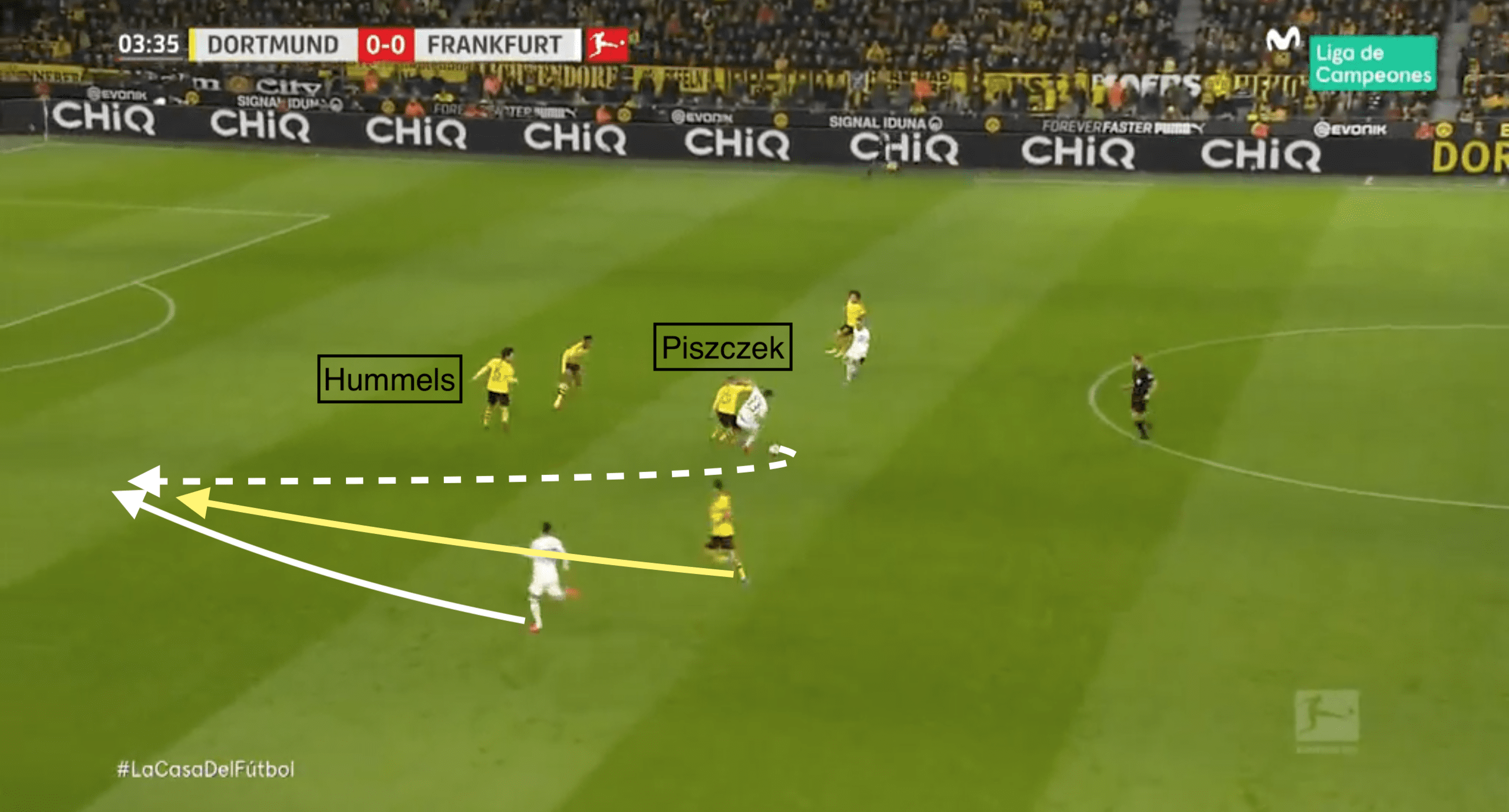
In the image above, three Dortmund players are surrounding the Frankfurt player in possession, with right centre-back Lukas Piszczek closing the opposition player down. With the Polish international out of position and a clear passing option available for Frankfurt, Can has two options: 1) follow the runner who is running into space; 2) let Mats Hummels close the runner in behind down as he is a centre-back. The midfielder opts for the former, which is the right choice for several reasons.
As a tall midfielder, it can give you several disadvantages in terms of foot speed such as closing down opposition players in the press, as a player of Can’s stature will be slightly heavier on the feet and will thus either result in the opposition player beating the press or getting fouled. However, Can has great acceleration for his size and so can make up the distance to the winger, Filip Kostić, who is trying to run into space. The midfielder also knows that he can’t let Hummels close Kostić down given that the German defender is quite slow and will not be able to close the large distance between him and the Frankfurt winger. In addition to that, Can recognises that Hummels has his back turned to Kostić meaning that if Hummels does close him down, he will spend seconds trying to locate the winger which Dortmund cannot afford in that situation.
This instinctual decision and his willingness to track back and help defend might seem simple in real-time and the normal decision to make but it saved Dortmund from conceding a clear-cut opportunity. Following on from the earlier image, Kostić received the ball in behind and is through on goal but Can showcases incredible timing and technique in his slide tackle to put an end to the attack.
Tackling is one of Can’s strong suits when it comes to discussing his qualities defensively. As mentioned earlier, his size and defensive know-how give him a good edge but his technique in the tackle is very good makes him a solid defensive midfielder. He is equally as good at slide tackling as he is in a standing tackle and the example below will showcase the latter.
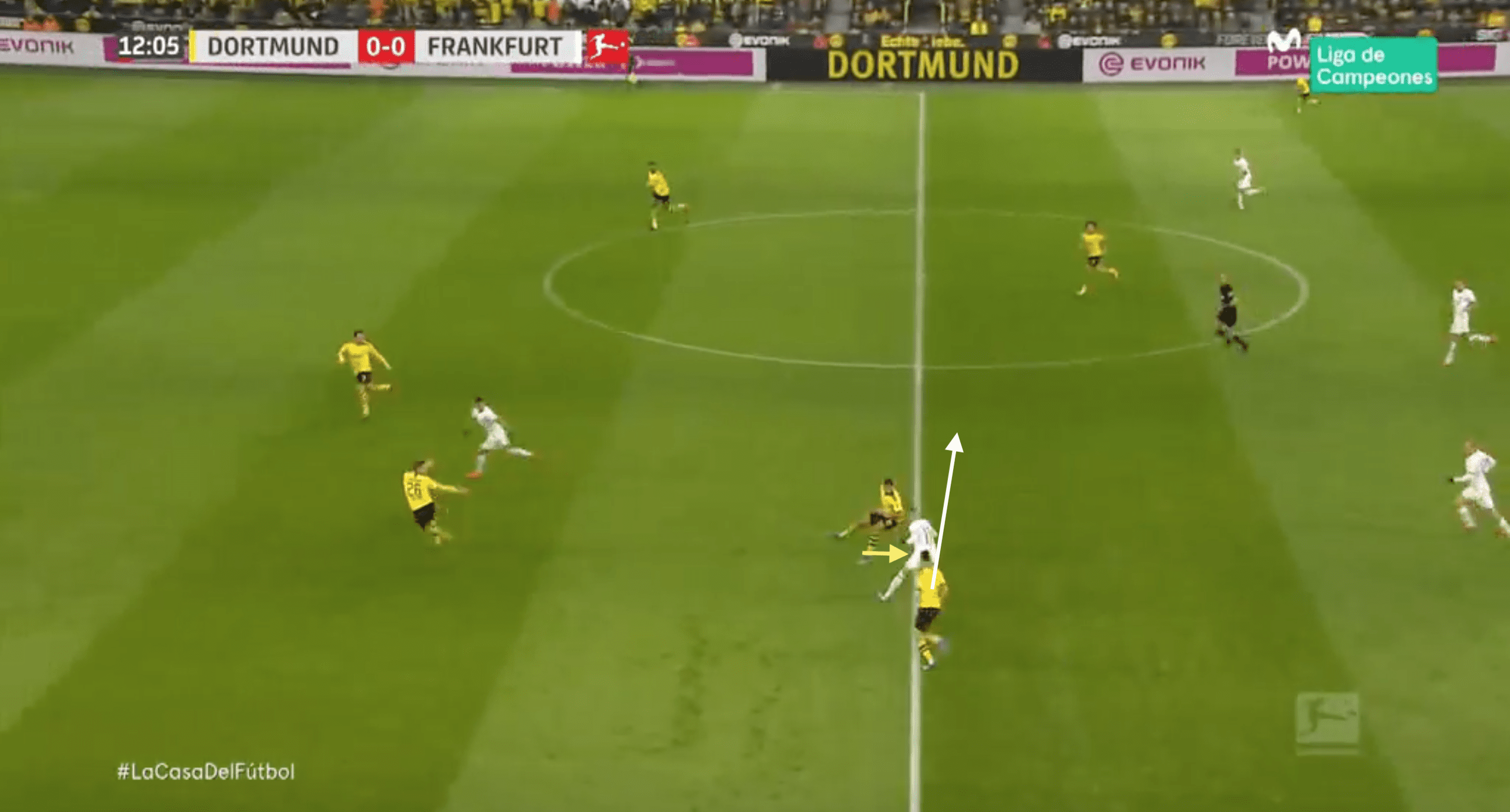
This frame is captured just after Dortmund lost possession cheaply with Gaćinović stealing the ball for Frankfurt and driving with it in the hopes of creating an attack. As there is no easy passing option in front of him, the winger knows he has to beat Can to progress the play and gives the German a great dummy. Can is momentarily on the back foot as the image shows giving Gaćinović the advantage as he now can drive into the middle and beyond Can.
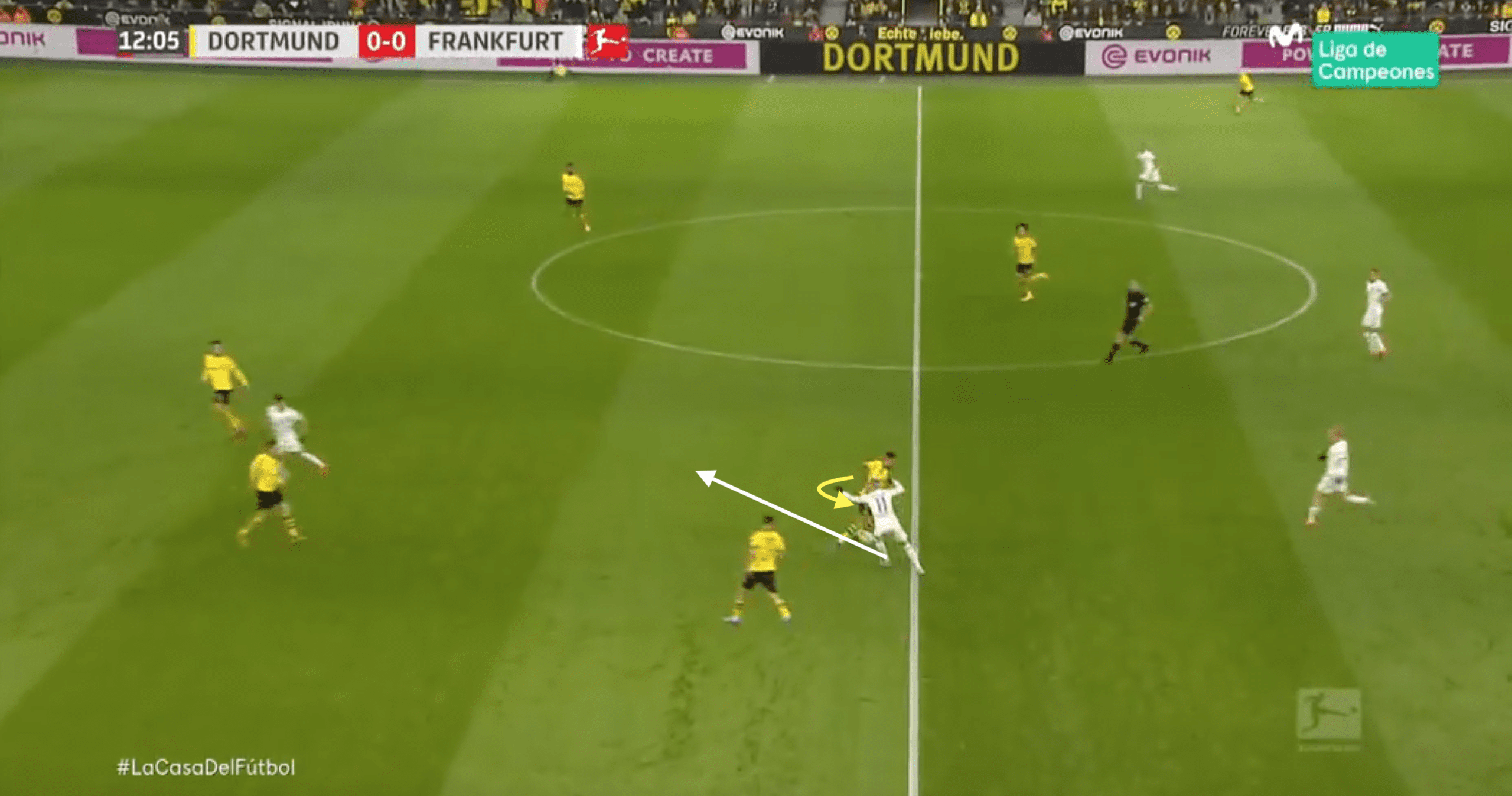
Instead of driving down the middle, Gaćinović tried to catch Can out by cutting back inside. However, the midfielder showcased incredible anticipation and was able to rotate his body quick enough to stick a leg out. The combination of anticipation, awareness and technique makes Can such an effective tackler. There are instances where he does get the tackle wrong, which is normal given his position, but his game intelligence is so good that he usually only commits these fouls to stop counter-attacks and ruin the opposition’s momentum.
Ball-carrying
An underrated aspect of the 26-year-old’s game is his dribbling ability. Can is deceptively skilful, with an array of step-overs and a variety of feints in his arsenal. Added with his strength and size, it makes him a nuisance to win the ball off. Normally bigger players tend to struggle with dribbling but Can’s footwork is great so that allows him to do tricks that players his size can’t do. Not only can he progress the ball with good technique, his spatial awareness with and without the ball mean that he usually does not turn over the ball in transition as he tends to make the right decision.
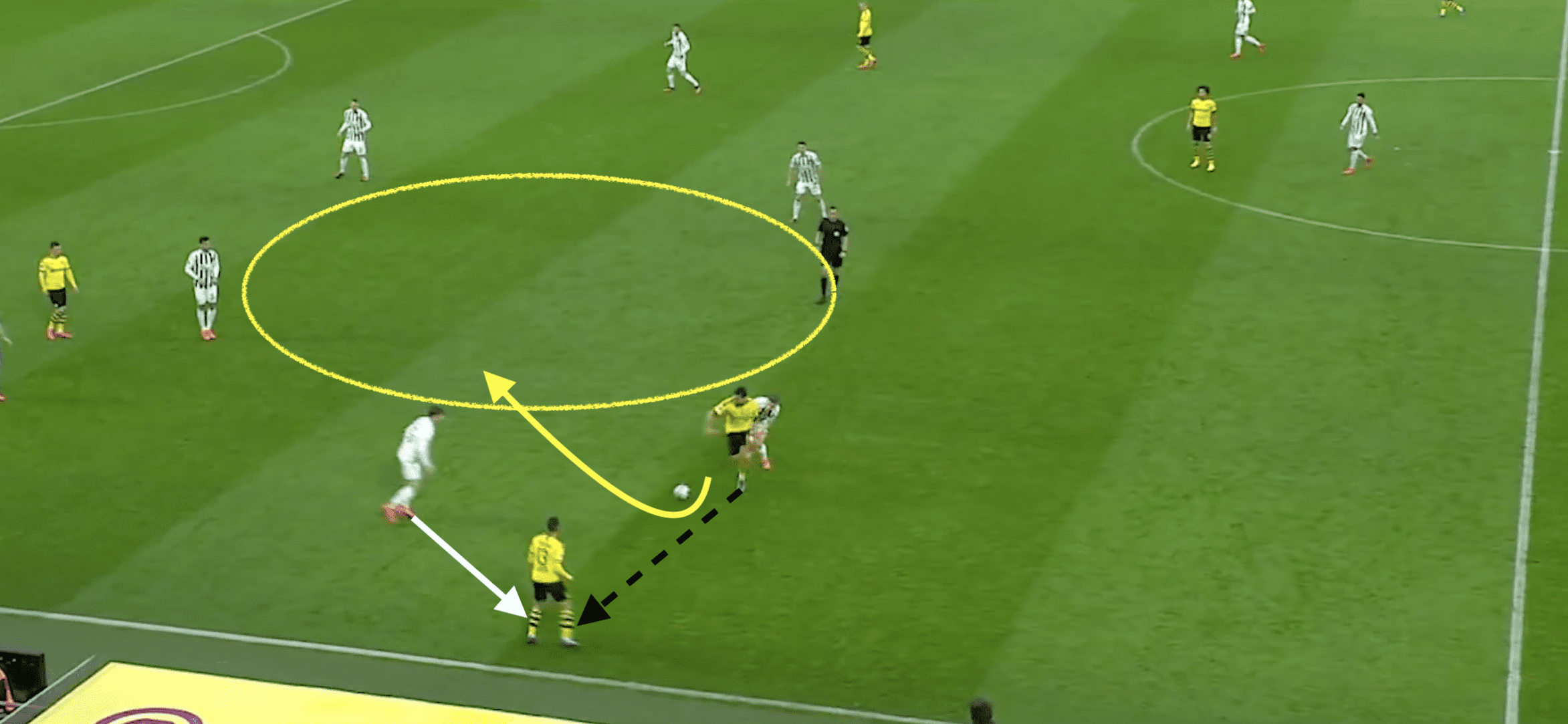
In the example above, Can has just won a duel against the opposition player and has the option to play an easy short pass in front of him to Raphael Guerreiro, which is shown by the black dotted arrow. However, the midfielder recognises that the opposition defender is looking to press Guerreiro so instead chooses to do a Thiago Alcantara-esque body feint into open space into the middle. Another simple but effective move – indicative of Can’s playing style.
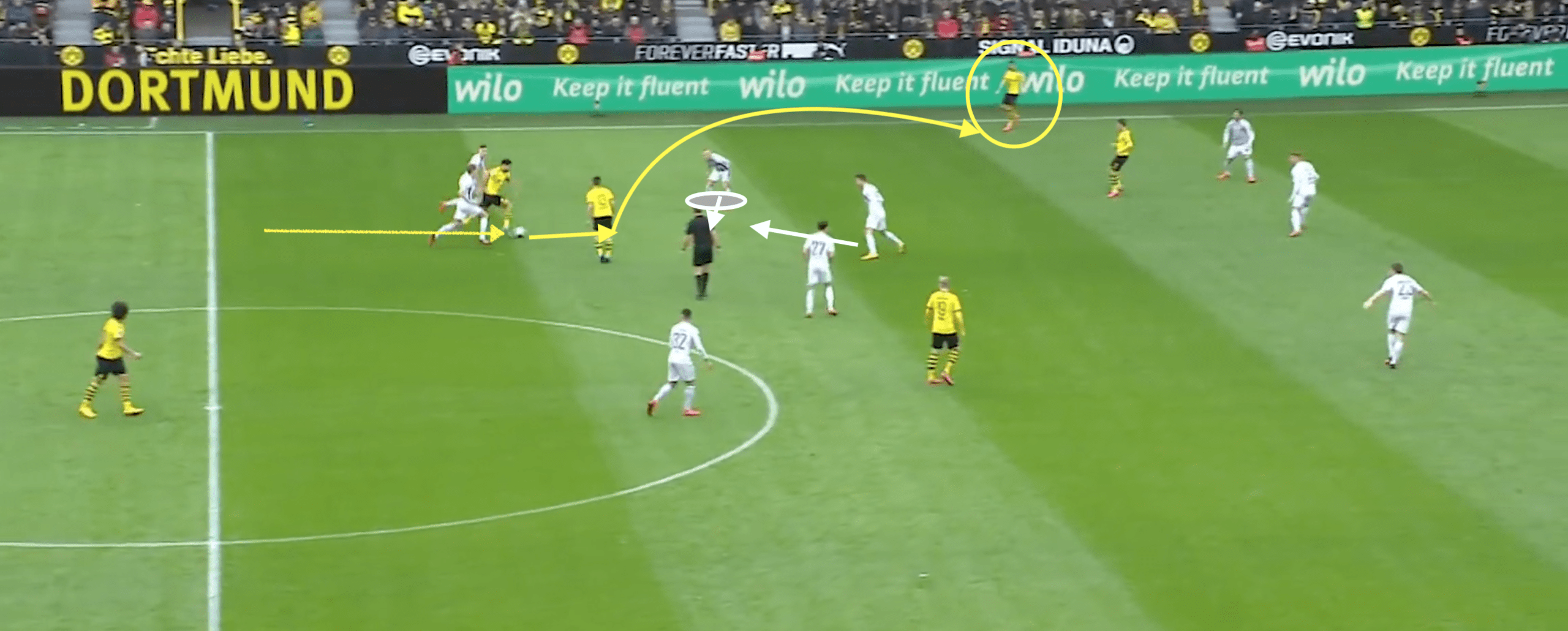
The image above highlights Can’s spatial awareness when carrying the ball. Having dribbled between two opposition players, two more are waiting to set a trap and win the ball back from him. Following a burst of acceleration, Can slows down a touch keeping the two defenders on his back whilst enticing the two in front of him to close him down. The two opposition players do try to close him down, but now a passing lane to Jadon Sancho is available and Can is able to easily find him. The German’s recognised that he had to drag the highlighted opposition defender closer to him so that he can play the pass to Sancho as that passing option helps Favre’s team to progress the play.
Can’s great quality in dribbling and ball-carrying adds another dimension to his game and allows him to be a more versatile player. His strength in this department helps masks the prevalent weaknesses in other areas, which will be looked at later on.
Comparison with Dortmund midfielders
To look at whether Dortmund made the right choice in signing Can permanently, he will have to compare favourably to his midfield partners. Six players featured in either a central or defensive midfield position for Favre this campaign but this just narrows down to four when we adjust for players with more than 800 Bundesliga minutes. The list of players include Can, of course, Axel Witsel, Thomas Delaney and Julian Brandt. It should be noted that Brandt has often featured in attacking positions meaning that his numbers are most likely skewed. He has played over 800 minutes in a central midfield position thus we are including him in this data comparison. First, we will look at each players’ defensive contributions.

Emre Can compares extremely well in the defensive categories ranking in the top two of each category except aerial duels per game. However, even in that category, the German has the highest aerial win percentage at 93.75%. Delaney does lead the majority of the statistical categories but it should be noted that not only are his win percentages in both aerial and defensive duels very low, he also only played 863 minutes. Witsel has been the mainstay in Favre’s side and does bring great value to the side and perhaps his numbers look bleak in comparison due to the fact he has played over 2000 minutes. The statistics show that Can is very good at intercepting and blocking shots, which speak to his great positioning and defensive IQ. Overall, Can ranks very favourably defensively compared to his teammates.

Above, we are looking at the passing qualities of each player and we have also included the number of dribbles per game as that is a tool that is used to progress play when you play in the middle of the park. As mentioned earlier, Brandt does play in attacking positions often thus it should come as no surprise that he leads in three out of the four categories. Can is close behind the former Bayer Leverkusen man in both progressive passes and dribbles per game putting up relatively similar numbers. Not only that, but his success rates in both very high and are also only topped by Witsel. Speaking of the Belgian international, his retention of the ball is exceptional as his pass accuracy is nearing the 95% mark with Can closing in on 90%. This statistic speaks to both players’ relatively simple passing approach which can also be seen in the very limited deep completions per game. Their role in the double pivot is to keep things simple, which is a huge reason for their high pass accuracy and low deep completion attempts per game. Once again, Can favours well in the passing and attacking front and thus, it becomes more clear as to why Dortmund opted to sign him permanently.
Role at Dortmund
Can’s role under Favre at Dortmund can be split into two different sections: defensive and possession. Can rarely has an attacking role given the setup and tactics of Favre. Since returning to Germany, Can has started seven times in midfield and has been paired alongside Witsel in every single outing. During this period, the Swiss manager has set-up Dortmund in a 3-4-2-1 or a 3-4-3 with Can and Witsel acting as a double pivot in front of the back three. The reason for this is to protect and screen the defensive so that when the full-backs, Guerreiro and Achraf Hakimi, go forward to support the attack, the double pivot can help defensively.
Dortmund tend to drop into a 5-2-3 formation when they are defending in the mid or deep block with Witsel and Can the pairing in the middle. The distance between the two is very small and they occupy the middle of the pitch and leave the half-spaces wide open. By doing this, Dortmund invite teams to play into it.
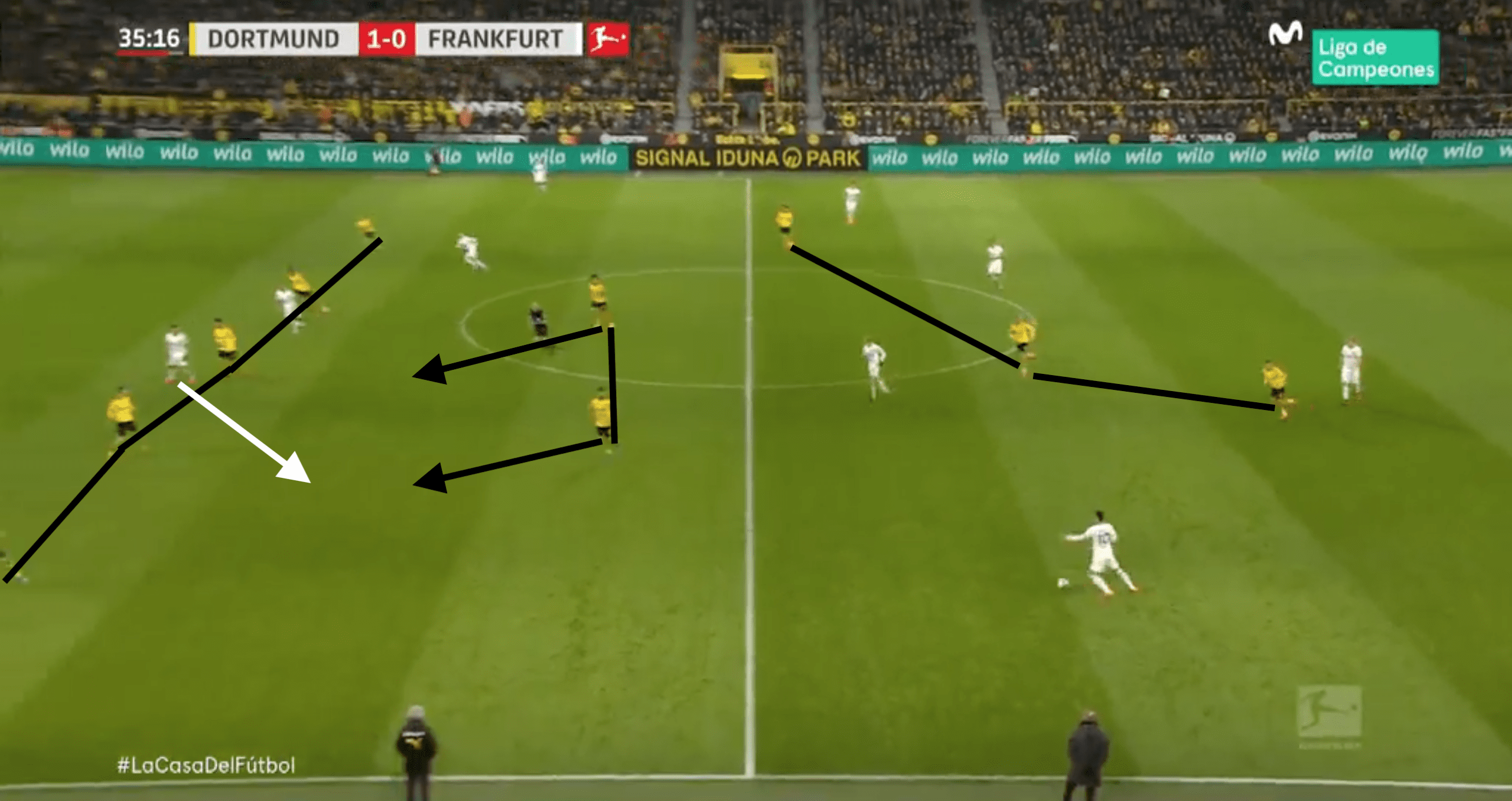
The reason for the shape and structure as shown in the image above is so that Dortmund can win the ball back via the double pivot of Witsel and Can. In this example against Frankfurt, if the striker drops into space, Can will slide along to cover that passing lane so that the defender in possession will have to play the pass to a wide player. As Can slides over to provide pressure, Witsel will then provide defensive cover in the centre of the pitch, protecting from any horizontal passes being made in the space between the line of five and the line of two. If the ball was on the other side, the roles in the double pivot reverse with Witsel providing pressure and Can covering for him. This structure ultimately results in the opposition being unable to play into the middle and it forces them to play longer diagonal passes or crosses, which are passes that are more likely to be intercepted.
In possession, the distance between the double pivot becomes much larger. This distance and the movement of both Can and Witsel give Dortmund a better chance in retaining possession and progressing the ball.
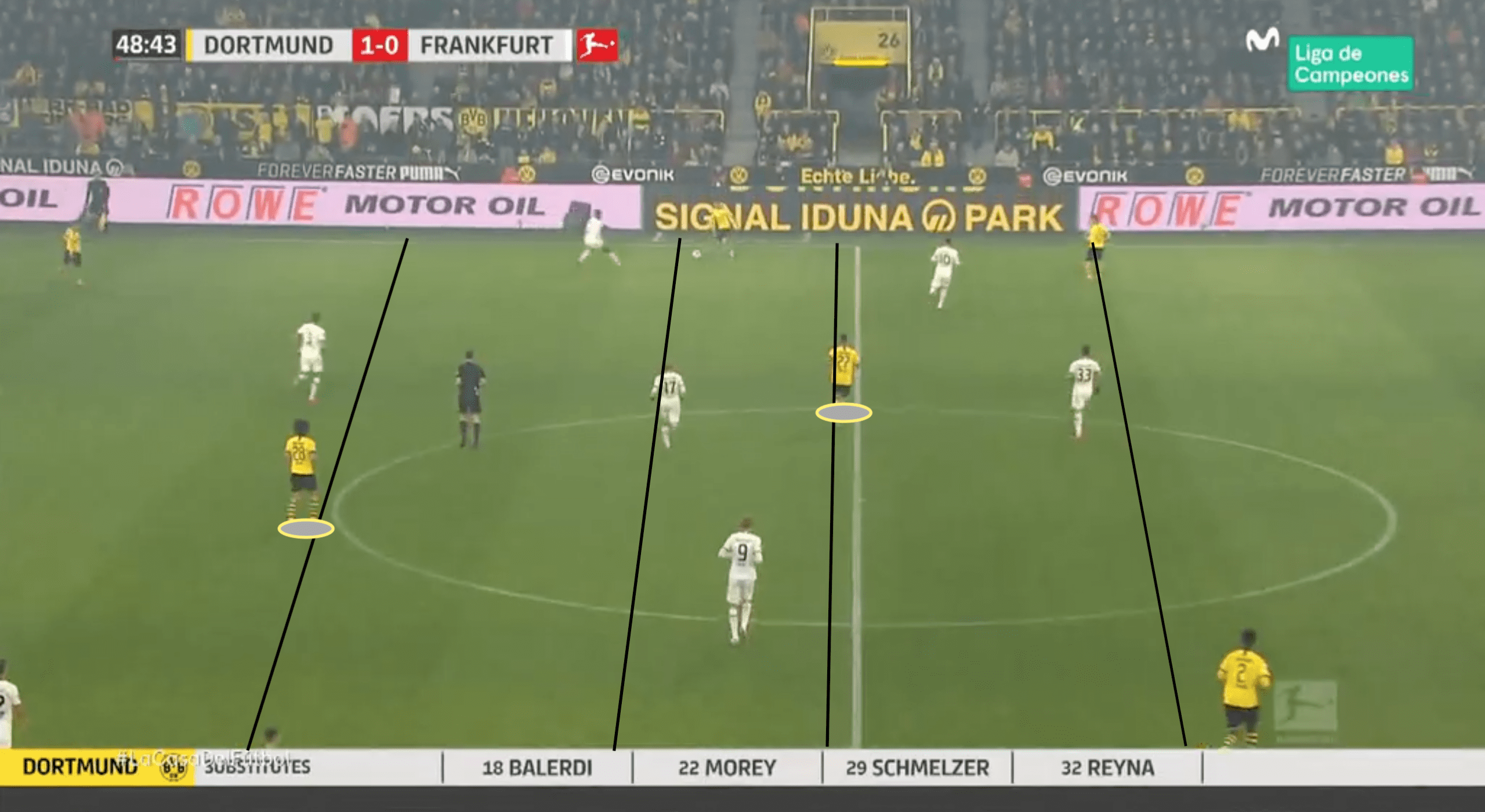
Both Can and Witsel are marked in a circle, with Can closer to the halfway line and Witsel higher up. In the Dortmund build-up in this instance, multiple horizontal lines were passing options for the player, Hakimi, in possession. If Witsel were to drop back to onto the same plane as Can, it becomes much easier for Frankfurt to cut the passing lanes and mark both of them at the same time. However, as they were not on the same line, Sebastian Rode, Frankfurt’s holding midfielder, is stuck in the middle of both Witsel and Can and has to decide to mark one of them, meaning that one of the players will be free for the pass. This strategy of staggering the double pivots is often used by Bundesliga teams, including Frankfurt, as it also helps the progression of the ball from the defence as usually one of the double pivots drop close to the defence to be an extra passing option.
Both Can and Witsel have mastered this positioning, especially when trying to play out of the back. Usually, it is Witsel who is further forward but they can switch it up often given their prowess in either position. This balance has made them an effective pairing when attempting to go forward and combined with their strengths in defence, it makes them a very solid midfield duo that Dortmund can rely on.
Issues
There are some holes in Can’s game that reduce his usefulness as a player despite his obvious strengths. Whilst he is great in possession and does not lose the ball very often, he can often choose the easy pass instead of trying to help Dortmund progress further up the pitch.
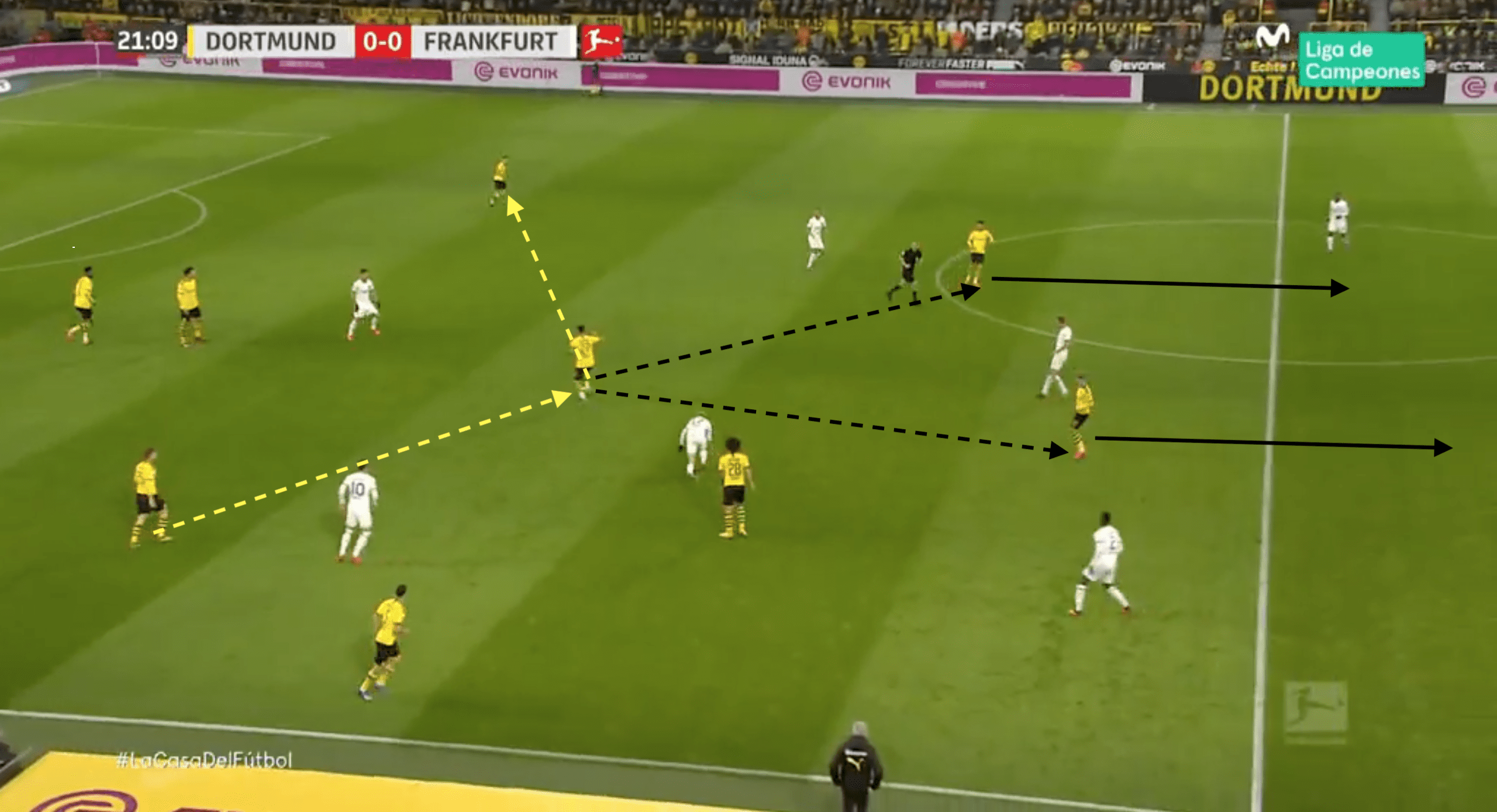
In this example, the midfielder receives the ball into feet and turns and plays a long pass into the left wing-back as shown by the yellow arrows. The black arrows show potential passing options that Can could have used to help Dortmund counter Frankfurt with Sancho and Hazard great threats on quick attacks. The pass that Can opted for is not a ‘wrong’ option but upon receiving the ball, he did not even glance or look around in all directions to see where all of his teammates are, which is, unfortunately, something that he does regularly and can cost him. His lack of constant head movement and taking mental pictures of his surroundings means he can only play where he sees. While that can be a good thing, especially for a player in his position, it can lead to him missing passing opportunities that could help Dortmund go forward. It also means that he is unable to showcase a good range and variety of passes, which is a hindrance to his versatility as a defensive or central midfielder.
Earlier in the same game, he gets caught because of his lack of awareness of his surroundings and an overall lack of concentration.
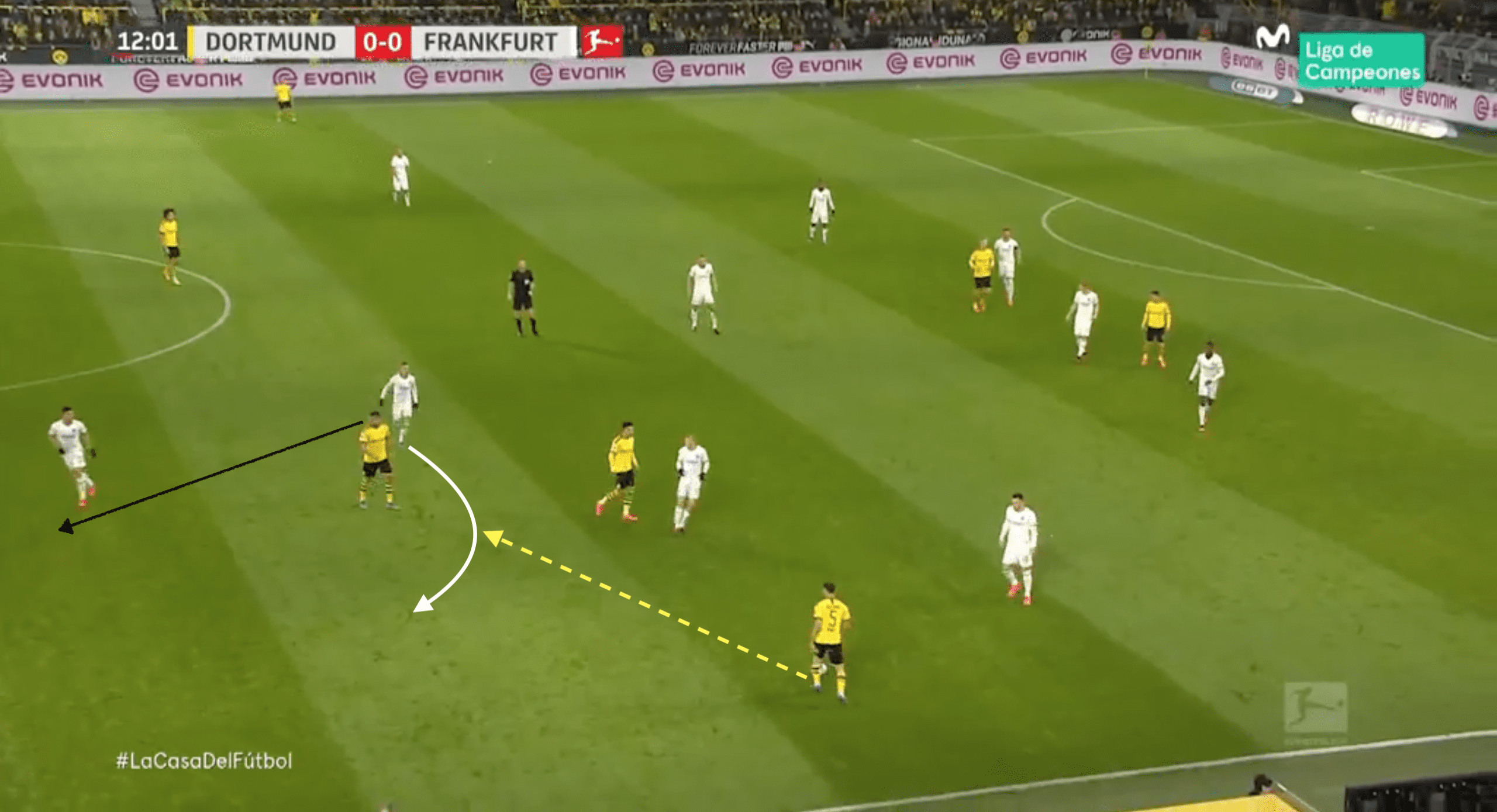
Here, Hakimi looks to play a simple pass into Can’s feet and he’s constantly checking the right-hand side but does not check the left-hand side or behind him. Once the pass is played into him, the Frankfurt player ghosts in front of Can without his knowledge and is able to intercept the pass and lead a counter-attack.
In terms of systematic issues alongside Witsel, there have so far been no issues apart from sometimes getting caught too high and leaving a gap that is slightly too big between the double pivot and the defence. However, this does usually happen in either set-pieces and counter-attacks and thus are somewhat inevitable. The communication, movement and positioning between both players are very good but a pairing of Can and Delaney is yet to be tested out and could see potential problems, given that they are both more defensively minded players as evidenced by the statistics.
Final remarks
Overall, the signing of Emre Can is a huge positive for Borussia Dortmund and Lucien Favre as they hope to build a team that can stop Bayern Munich from winning the Bundesliga title in the next few years. The German midfielder was unable to showcase his talent in Serie A this season but his defensive prowess, leadership and game intelligence are much needed attributes for Dortmund.
However, with Favre’s future reportedly in doubt, Can’s weaknesses could perhaps relegate him into being a role player under a different manager as the system under Favre has ultimately gotten the best out of his traits.





Comments